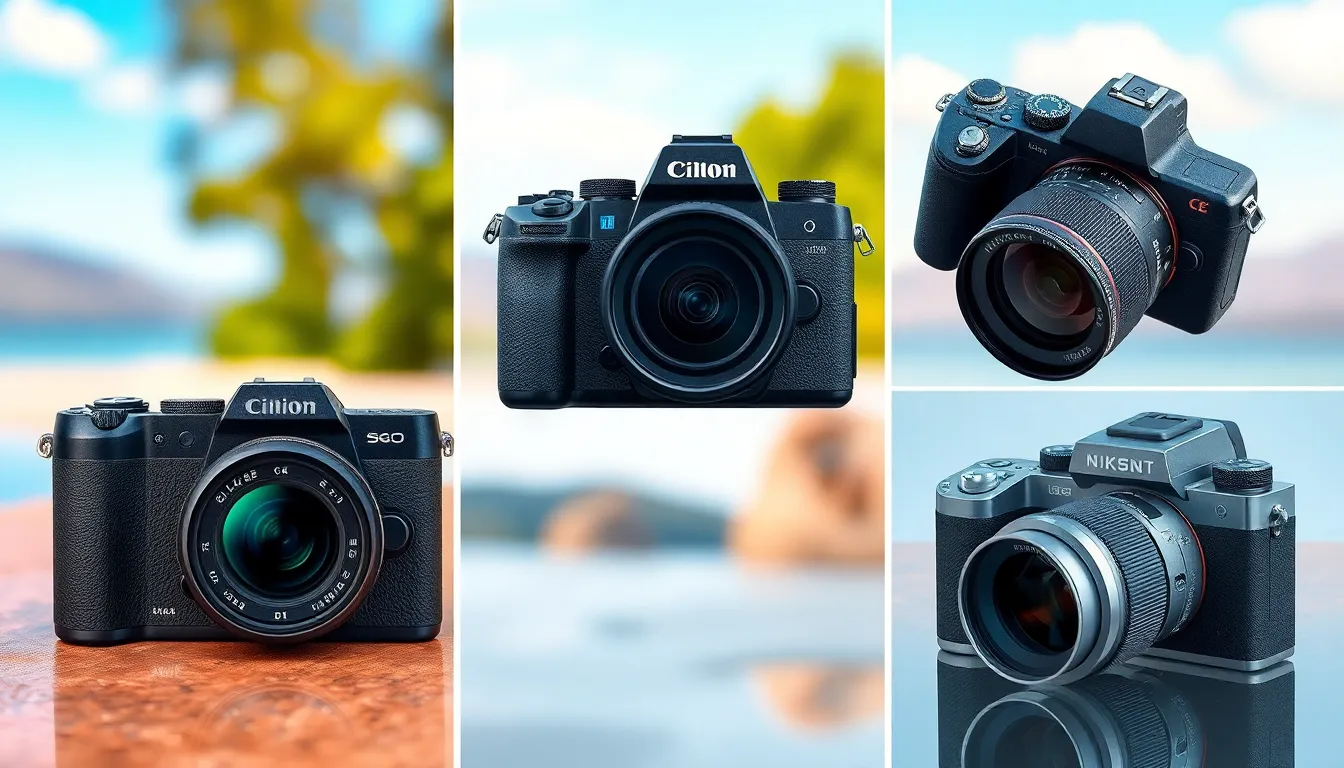Table of Contents
ToggleIn today’s fast-paced digital world, capturing moments has never been easier or more important. Digital cameras have revolutionized photography, offering stunning image quality and versatility that traditional film cameras simply can’t match. From casual snapshots to professional-grade photography, these devices cater to a wide range of needs and skill levels.
As technology advances, digital cameras continue to evolve, featuring impressive innovations like high-resolution sensors, advanced autofocus systems, and connectivity options that make sharing images a breeze. Whether someone is a budding photographer or a seasoned pro, understanding the various types of digital cameras available can help them make informed choices and elevate their photography game.
Overview of Digital Cameras
Digital cameras capture images electronically, utilizing sensors instead of film. They offer superior image quality, with many models featuring high-resolution sensors that enhance detail clarity. Advanced autofocus systems further improve image capturing, making it easier for users to achieve sharp focus.
Digital cameras fall into several categories, including:
- DSLR Cameras: Digital Single-Lens Reflex cameras combine advanced technology with interchangeable lenses, providing flexibility for various photography styles. They often feature larger sensors, contributing to improved image quality.
- Mirrorless Cameras: Compact and lightweight, mirrorless cameras use electronic viewfinders and interchangeable lenses. They excel in fast shooting and video recording capabilities, attracting both enthusiasts and professionals.
- Point-and-Shoot Cameras: Designed for convenience, point-and-shoot cameras offer compact designs and automatic settings. They’re ideal for casual photography and widely accessible.
- Action Cameras: Built for capturing fast-paced environments, action cameras are compact and durable. They withstand extreme conditions, making them suitable for adventure photography.
- Smartphone Cameras: Integrated into mobile devices, smartphone cameras provide significant convenience. With advancements in lens technology and image processing features, they often deliver impressive results for everyday use.
Understanding these categories aids users in selecting the right camera based on preferences and photography goals. Digital cameras continue evolving with new technology, enhancing features like low-light performance, connectivity options, and user interface, promoting creativity across all skill levels.
Types of Digital Cameras

Digital cameras come in various types, each serving specific needs and preferences in photography. Understanding these types helps individuals select the right camera for their unique requirements.
Point-and-Shoot Cameras
Point-and-shoot cameras prioritize simplicity and ease of use. These cameras feature fixed lenses and automatic settings, making them perfect for casual photographers. Most models include built-in image stabilization and autofocus systems. Popular options in this category include the Canon PowerShot series and the Sony Cyber-shot range.
DSLR Cameras
DSLR cameras provide versatility and superior image quality, particularly for serious photographers. They feature interchangeable lenses and larger sensors, which enhance light sensitivity and detail capture. Many DSLRs also support extensive accessories, such as external flashes and lens filters. Notable models include the Nikon D3500 and Canon EOS Rebel series.
Mirrorless Cameras
Mirrorless cameras combine advanced technology with a compact design, appealing to those who desire high performance in a lightweight package. These cameras eliminate the mirror mechanism found in DSLRs, resulting in faster shooting speeds and better video capabilities. They also support interchangeable lenses and have seen impressive advancements in autofocus functions. Leading examples include the Sony Alpha series and the Fujifilm X-T series.
Key Features to Consider
When choosing a digital camera, several essential features affect performance and usability. Understanding these key aspects helps photographers select the right equipment for their needs.
Image Quality
Image quality primarily depends on the camera’s sensor size and resolution. Larger sensors, such as full-frame options, offer superior dynamic range and low-light performance. Cameras with high-resolution sensors, often in the range of 20 to 50 megapixels, capture intricate details and provide flexibility for cropping in post-production. Additionally, the lens used influences image sharpness and color accuracy, making it crucial to pair high-quality lenses with capable cameras.
Lens Options
Lens options significantly affect creativity and versatility in photography. Interchangeable lens systems, found in DSLR and mirrorless cameras, allow for tailored experiences with various focal lengths and apertures. Common types of lenses include prime lenses for sharp images at fixed focal lengths, zoom lenses for flexibility in composition, and specialty lenses like macro or wide-angle for niche photography styles. Assessing compatibility with existing lenses or future lens investments is vital in the selection process.
Battery Life
Battery life plays a crucial role in a camera’s usability, especially during events or extended shoots. Many digital cameras offer battery life ranging from 300 to 1,000 shots depending on usage and settings. Look for cameras with energy-efficient technologies, such as electronic viewfinders or power-saving modes, to maximize shooting time. Additionally, consider the availability of spare batteries or options for USB charging to enhance mobility during photography sessions.
Best Digital Cameras in 2023
Digital cameras in 2023 showcase remarkable advancements, catering to various budgets and preferences. This section highlights top picks across different price ranges.
Budget Options
Budget-friendly digital cameras provide excellent value without compromising on quality. Notable options include:
- Canon PowerShot SX620 HS: This compact point-and-shoot features a 20.2 MP sensor and 25x optical zoom, perfect for travel photography.
- Nikon Coolpix B500: With a 16 MP sensor and 40x optical zoom, this camera offers versatility and easy connectivity via Bluetooth and Wi-Fi.
- Fujifilm FinePix XP140: This rugged camera boasts a 16.4 MP sensor, waterproof design, and 5x optical zoom, ideal for outdoor adventures.
These models cater to casual photographers seeking reliable performance without overspending.
High-End Picks
High-end digital cameras deliver exceptional performance and features for serious photographers. Recommended models include:
- Sony Alpha 7 IV: This full-frame mirrorless camera features a 33 MP sensor, advanced autofocus, and 10 fps continuous shooting, perfect for capturing fast action.
- Canon EOS R5: Known for its 45 MP sensor and 8K video capabilities, this mirrorless camera excels in both photography and videography.
- Nikon Z9: A flagship mirrorless model, it offers a stacked CMOS sensor, 20 fps continuous shooting, and impeccable image quality, catering to professional needs.
These top-tier cameras provide superior capabilities suited for advanced photography, making them a worthwhile investment.
Digital cameras have revolutionized the way people capture moments and express creativity. With numerous options available ranging from DSLRs to smartphones there’s a perfect fit for every photographer’s needs. The advancements in technology continue to enhance image quality and usability making it easier for anyone to take stunning photos.
As photographers explore different types of cameras they can find models that not only meet their technical requirements but also inspire their artistic vision. By understanding the unique features and capabilities of each category individuals can confidently choose the right equipment to elevate their photography journey.





